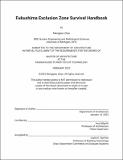Fukushima Exclusion Zone Survival Handbook
Author(s)
Zhao, Mengqiao
DownloadThesis PDF (100.6Mb)
Advisor
Miljački, Ana
Terms of use
Metadata
Show full item recordAbstract
Ten years have passed since the 2011 Fukushima nuclear accident in Japan, but its devastating impact has not subsided and may never end, given the radioactivity from the long-term decay period. As one of the most serious nuclear accidents in human history, this is a disaster not only for Japan but for the whole world. Radioactivity has no boundaries, whether for countries or species: both humans and nonhumans are impacted.
Challenging traditional problem-solving methods that focus on overcoming, solving, remediating and isolating, this thesis proposes an unconventional method of coexisting with radiation in a survival handbook. “The Survival Handbook of the Fukushima Exclusion Zone” is a fiction and an imaginative guide that describes how to coexist in a future radioactive world. It is designed for humans -- residents and visitors returning to the site--and nonhumans--flora and fauna and nuclear waste itself. Based on an investigation of both traditional and promising new materials, this book offers schemes for imagining the future in this radioactive world. Organized around future daily life in the Fukushima Exclusion Zone, this project investigates whether all forms of life can live in a radioactive world and how we might do so. At the scale of atoms, bodies, buildings, and landscapes, the timeframe of the design proposed in this thesis ranges from an almost negligible nuclear reaction time to the whole nuclear waste decay period, lasting more than 10,000 years.
Date issued
2022-02Department
Massachusetts Institute of Technology. Department of ArchitecturePublisher
Massachusetts Institute of Technology